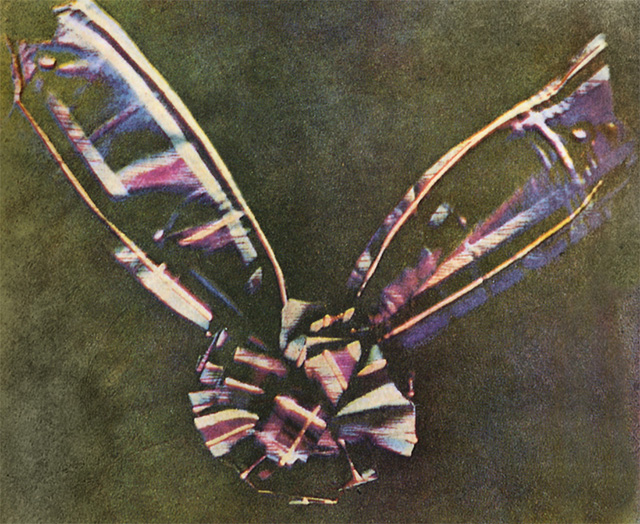Development of Colour Photography
Fishermen on a boat. Hand colored albumin print by Felice Beato, Kusakabe Kimbei, or Raimund baron von Stillfried, Japan, ca. 1870-1890.
Hand-colouring
After establishing a stable portable and affordable photographic process, people wanted to capture the amazing colours of our world. They started with tinting daguerreotypes and calotypes by hand. Hand colouring became big in Japan and became a defining characteristic of Japanese tourist photography.
Lippmann’s flowers photograph created in the 1890s
Colour through interference
The first experiments started in the mid 19th century and was achieved by physicist and inventor, Gabriel Lippmann. In 1886 he created the first colour photograph without the aid of pigments or dyes. Lippmann used a phenomenon known as interference to achieve this. This is where two waves superpose to forma result wave of greater, lower or same amplitude. He was awarded a Nobel Prize in Physics for his discovery.
Lippmann’s process of using the interference phenomenon was complex and had it’s drawbacks though. Long exposure times, fine-grained high resolution emulsions were needed, it didn’t do well with reflections and required a process using toxic mercury.
Maxwell’s Ribbon Photograph
Start of RGB
During this time a Scottish physicist James Clerk Maxwell was working on a new colour theory, which he presented to the Royal Institute in 1861. He’s idea was to photograph a scene through red, green and blue filters. If these overlap with the matching filters, a complete colour image is created.
This method was pushed to the background until a German Scientist, Hermann Wilhelm Vogel used the three-colour theory to create emulsions that were only sensitive to particular colours by adding dyes. This process took time to be refined and only until the early 20th century accurate and sensitive enough to use in traditional photography.
Layers of colour
As taking the same photograph three times using three different lenses was complicated, two camera types were developed. One used a lens that could separate incoming light though 3 filters and taking 3 photographs at the same time. The second one had to take separate images but had a drop back to make the swap of filters and emulsion types quick and ‘easy’.
Untitled, Louis Arthur Ducos du Hauron
Louis Decos de Hauron started to lay three different colour emulsion on top of each other that can be exposed at the same time. This was an important step to send the colour photography to where it is now, only problem was that each layer tended to soften the light as it passed through the emulsion.
This was not a perfect process but send photographers happily on their way, capturing colour. In the 1930’s Agfa-Ansco produced a roll type film for snapshot cameras. These rolls were sent back to the supplier for development, but were still not sharp enough.
The Kodak, Agfa race
In 1935 Kodak released a ‘tripack’ film, Kodachrome, developed by Leopold Mannes and Leopold Godowsky. This due of musicians were hired by Kodak Research Laboratories and created a colour positive (or slide) film produced with a subtractive colour photography method. Although the processing of this film were complicated and had to be sent back to Kodak, the rich warm tomes and sharpness made it the preferred film for over 70 years. In 1936, Agfa was able to refine Kodak’s development process by developing all three layers at one time as well as developing the Agfacolour negative-positive process. This was only released in 1949 because of World War II that gave Kodak a chance to release their negative-positive film, Kodacolor, in 1942.
And there was colour...
In the beginning 1960’s colour film started to make their mark in the market but was still much more expensive that black & white file. By the 70s the prices started dropping to be accessible to the masses and by the 80’s stated taking over to be dominant medium used for daily snapshots of life. It started gaining acceptance and could be found from amateur holiday shots to photographs on the moon.
Untitled, William Eggleston
Artists, like William Eggleston and Ernst Haas started using colour photography as an creative expressive medium. Newspapers started to embrace colour images when the Illustrated London News printed colour pictures in their Christmas Day edition on 1855. This was a once off though and only really caught on in the 1950’s and after. While magazines started using colour photography in the 1890’, the printing was still unreliable and only became a standard in the 1920’s
With colour photography was taken to another level. Allowing true expression for the masses and a visual sensation for the eyes. Now understanding the complications on being able to capture colour we can step into the digital age…






